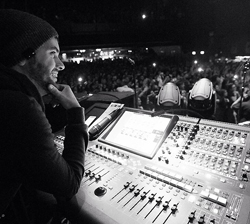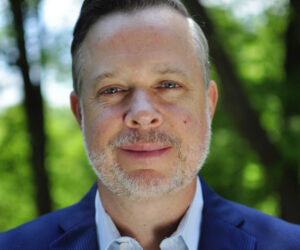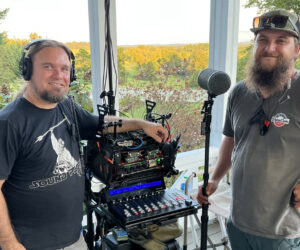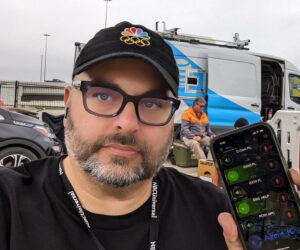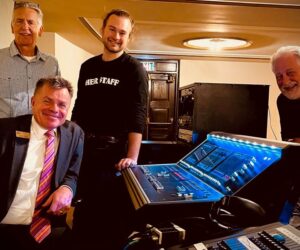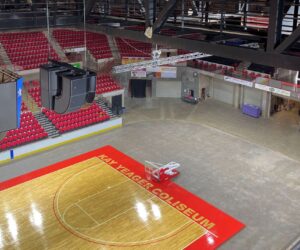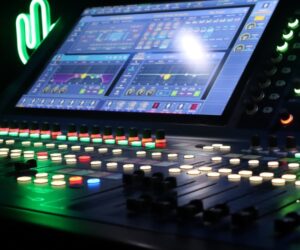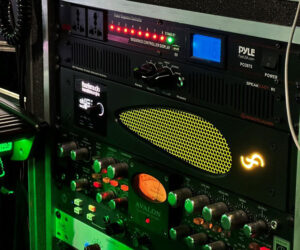Supporting their new album, Future Hearts, Baltimore-based punk/pop band All Time Low will be touring heavily throughout 2015. As always, the entire band will be using Sensaphonics in-ear monitors on stage.
“We’ve all used Sensaphonics for years now, and they have never let us down,” notes guitarist Jack Barakat. “I’ve had problems in the past because of the amount I run around on stage, but with Sensaphonics I’ve never had an issue with a perfect seal and a perfect sound. Whether in the studio or touring around the world, I’m never without my Sensaphonics.”
The group is currently on tour in the U.S., again working with production manager and monitor Daniel Nickleski of Sound Works Productions (Frankfort, IL). Guitarist Barakat, lead singer Alex Gaskarth, and drummer Dawson all use the Sensaphonics 2MAX, while bass player Zack Merrick has opted for the 3MAX triple driver. “The band has a strict ‘no speaker cabinets on stage’ rule, and Zack loves that extra bit of low end the second bass driver in the 3MAX gives him.”
Nickleski credits Sensaphonics’ sonic accuracy and soft silicone construction for the band’s loyalty. “Just from a comfort level, the band and I love them,” says Nickleski. “They sound very accurate and natural, the isolation is superb, and they keep their seal better than anything else out there, which is huge on stage.”
With ten years of touring experience, Nickleski has tried just about every major IEM on the market. “I’m kind of an audio nerd and want to check everything out, so I have a set of every IEM under the sun,” he reports. “They all sound good, some with more low end, others with more highs, but mostly they’re just loud. And they pack six or eight drivers into their ears to make it sound as good as a dual-driver Sensaphonics. So when I hear about a new model with 20 drivers, I know it’s just marketing.”
Asked about the role of the monitor engineer in hearing health for the band, Nickleski says it depends on the artist. “I just try to be knowledgeable and professional,” he reports. “All Time Low gets it, and they have learned they really don’t need to listen at extreme volumes. Other bands can be more difficult. I do feel like it’s my job to tell them when they are crazy loud, but if they want to turn it up at their bodypack again later in the show, that’s their decision. Plus, as a sound engineer, you never want to get fired, so you have to walk that fine line.”
To help keep things under control, Nickleski has developed a few techniques to help give his artists what they want without destroying their hearing. “When someone needs to hear more of their own instrument, I don’t just turn it up,” he says. “The real problem is usually the other instruments being too loud, or maybe the high end of the bass is competing with the lows on the guitar. So I might use some EQ to control the bass and maybe pull the other tracks down a bit to let the guitar pop out better. That lets me provide ‘more me’ without more volume.”
Nickleski takes good care of his own ears, with regular checks at the Sensaphonics Musicians Hearing Clinic in Chicago. “I’m based in the south suburbs, so I pop in there once a year if not more,” he says. “Dr. Santucci really takes care of me, and has taught me a lot about keeping things safe, both for me and my artists. And when All Time Low plays Chicago, we usually schedule a visit.”
In general, Daniel Nickleski sees today’s young artists as understanding the importance of hearing health to a career in music. “The old rock and roll mentality was always about making it louder, but things are different these days,” he says. “We’re trying to make it sound better, not just louder. Sensaphonics gives us the tools to do that, and to save some hearing while doing it.”


